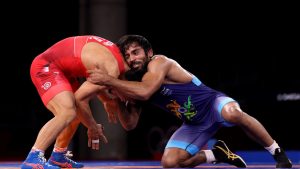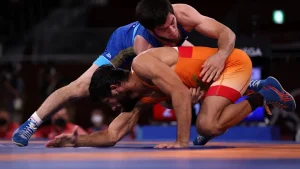A victory by countout (eng. countout, count out) is awarded to a wrestler standing in the ring, whose opponent was not able to climb into the ring during the time counted by the referee. As a rule, the countdown in standard types of matches is up to ten, in Japan – up to twenty. If both wrestlers do not have time to climb into the ring before the time expires, the match ends in a draw.
The countdown starts again as soon as the wrestler, who is in the ring, goes down to the mats outside the ring (this technique is called “breaking the count” by American commentators. If the wrestler comes back, the count continues for his opponent. If both wrestlers return to the ring, the referee stops the count .
A countout loss is also considered a disqualification of a wrestler for not interrupting a painful hold on an opponent who reached the ropes within five seconds.

In many title match promotions, losing a champion by countout usually does not result in the loss of the title. Either way, the person in charge of scheduling fights can add a condition in which the champion can lose the title by losing by countout.
Disqualification
Disqualification (English abbreviation – DQ) happens if one of the wrestlers violates the rules of the match, which automatically leads to his loss in the current match. By the way, a loss by countout can also be considered a disqualification (the match ends with the defeat of the wrestler who violated one of the rules of the match), but at the same time, as a rule, disqualification and defeat by countout are separated as different concepts. Normally, no disqualification matches will also override the out-of-the-ring rule, but there are rare cases where the out-of-ring count continues even in a No DQ match.
Disqualification can come in the following ways:
- The wrestler conducts dishonest and illegal moves or strikes. An example is again the refusal to stop the pain within five seconds after the opponent has reached the ropes, as well as the techniques prohibited by the universal unspoken rules – grabbing the hair, poking in the eyes, strangling, biting. Striking with a closed fist is also prohibited.
- Intrusion into the match by an outside wrestler and his subsequent attack by one of the wrestlers leads to the victory of the attacked and automatic disqualification of his opponent. Sometimes friendly wrestlers use such tricks – one attacks the other, which leads to his victory in the match. An example is a match in WWE in
- February 2009, when Shawn Michaels, who was on the side of John “Bradshaw” Layfield, attacked him, which led John to an easy victory.
- Hitting an opponent with a foreign object that is not allowed to be used in the match.
- Use of methods prohibited by the promotion.
- Directed blow to the groin. “Directed” is the main word here, because, for example, the inverted atomic drop, being directed precisely at the area between the legs, is not prohibited and its use will not lead to disqualification – after all, the reception is directed not at the groin, but at the opponent’s tailbone.
- Intentional or accidental attack on the referee.
- Grabbing a wrestler by the clothes during a hold is also prohibited, but disqualification for this is extremely rare – most often the judge simply stops the hold countdown.
- In Mexican and Japanese wrestling promotions, it is forbidden to pull off the mask on the face of the luchador.
In the National Wrestling Alliance, a disqualification occurs for throwing a wrestler out of the ring over the top rope. - In a Battle Royale match, it is forbidden to enter the ring if the wrestler is not a participant in the match or the time has not yet come for him to enter.
- In a mixed tag team match (wrestler+wrestler) it is forbidden for a wrestler to attack a female wrestler and vice versa. WWE had frequent wrestler-versus-wrestler matches in the late 90s, but after Vince McMahon’s match against his daughter, Stephanie McMahon, these types of matches became less frequent.

In moments when the referee is distracted and does not see the fact of a violation of the rules, disqualification does not occur. As a rule, the referee will immediately end the match by disqualifying one of the wrestlers after being hit in the groin, hit by a foreign object, being invaded by an outside wrestler, or after attacking the referee himself. In WWE, disqualification occurs only if the referee saw the fact of a violation of the rules – even watching the video does not solve the situation (in some cases, mini-plots are held with videos and judges – a disgruntled wrestler, against whom the rules were violated, provides a record and demands an explanation from the referee). However, not all attacks on the referee result in disqualification of the attacker – the notorious “referee-bumps”, after which the referee is in a state of knockout, are most often carried out to add drama to the match – after the “referee-bump” has been made, one one of the wrestlers can start a hold, hold a submission or break the rules, but the referee will not be able to see this and it will not be fixed at the end of the match.
